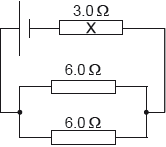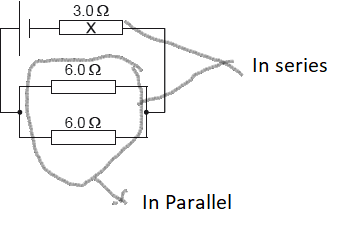Question
\(\mathrm{P}\) and \(\mathrm{Q}\) are two conductors of the same material connected in series. \(\mathrm{Q}\) has a diameter twice that of \(P\).
What is \(\frac{\text { drift speed of electrons in } P}{\text { drift speed of electrons in } Q}\) ?

A. 4
B. 2
C. \(\frac{1}{2}\)
D. \(\frac{1}{4}\)
▶️Answer/Explanation
Ans:A
The drift speed of electrons in a conductor depends on various factors, including the current passing through the conductor and its properties. In this scenario, since conductors P and Q are connected in series, they carry the same current. The drift speed is primarily determined by the current, cross-sectional area, charge of the electron, and the number density of electrons in the material.
Let’s consider conductor P with diameter \(d\) and conductor Q with diameter \(2d\). The cross-sectional area (\(A\)) of the conductor is directly proportional to the square of its diameter. So, for conductor Q, the cross-sectional area is four times that of conductor P.
Given that the current is the same through both conductors and the drift speed is inversely proportional to the cross-sectional area, we can compare the drift speeds of electrons in P and Q as follows:
\[
\frac{\text{Drift speed in P}}{\text{Drift speed in Q}} = \frac{A_Q}{A_P} = \frac{4A_P}{A_P} = 4
\]
So, the drift speed of electrons in conductor P is four times that of conductor Q.
Question
Three lamps (X, Y and Z) are connected as shown in the circuit. The emf of the cell is 20V. The internal resistance of the cell is negligible. The power dissipated by X, Y and Z is 10W, 20W and 20W respectively.

What is the voltage across Lamp X and Lamp Y?

▶️Answer/Explanation
Ans:B
Question
Two resistors of equal resistance R are connected with two cells of emf e and 2e. Both cells have negligible internal resistance.

What is the current in the resistor labelled \(X\) ?
A. \(\frac{\varepsilon}{2 R}\)
B. \(\frac{3 \varepsilon}{2 R}\)
C. \(\frac{\varepsilon}{R}\)
D. \(\frac{3 \varepsilon}{R}\)
▶️Answer/Explanation
Ans:C

Potential Difference across X
$2\varepsilon-\varepsilon=\varepsilon$
Potential diff. =current $\times R$
current \(=\frac{\varepsilon}{R}\)
Question
Two secondary cells require recharging. Which circuit will recharge both cells?

▶️Answer/Explanation
Ans:A
When recharging a cell or battery, it’s important to connect the positive terminal of the charger to the positive terminal of the cell and the negative terminal of the charger to the negative terminal of the cell. This ensures that the electrical current flows in the correct direction, allowing the battery to be charged safely and efficiently. Reversing the polarity, i.e., connecting positive to negative and vice versa, can be dangerous and may damage the battery or even pose safety risks. Always follow the manufacturer’s instructions when charging batteries to ensure proper and safe operation.
Which is only Possible in Option – A
Question
A cell of emf 6.0 V and negligible internal resistance is connected to three resistors as shown.
The resistors have resistance of 3.0 Ω and 6.0 Ω as shown.

What is the current in resistor X?
A. 0.40 A
B. 0.50 A
C. 1.0 A
D. 2.0 A
Answer/Explanation
Markscheme
C

\(\frac{1}{R_1} =\frac{1}{6}+\frac{1}{6} =\frac{2}{6}\)
\(\therefore R_1 =3\)
\(R_{eq} = 3+3 = 6\)
\(i =\frac{V}{R_{eq}} =\frac{6}{6} = 1\;A\)